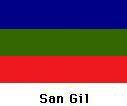 |
 |
XXIV. THE TRIBUNAL
The Guanent Judicial District was created by the New Granada Congress at the
beginning of last century. One of the most famous jurists attended the courtroom
with espadrilles. The list of Tribunal Magistrates. He gures as one of the most respectable
in the Colombian Forum. Hermeneutic magazines.
The Congress of New Granada dispatched a decree by which the Santandereanas Provinces
were segregated from the Tunja Jurisdiction, and created at the same time, the Judicial
District of Guanent with headquarters in the City of San Gil. The Superior Tribunal
functioned in this city until 1857. In this year, the Sovereign State of Santander
was created with the capital in the City of Socorro, where the Seat of the Santander
Supreme Tribunal was transferred. It had a very extensive jurisdiction. Law 25 of
February 28, 1888 divided the Jurisdiction of this Tribunal into two districts, the
Tribunal District of the North and the Tribunal District of the South., the latter
one with headquarters in Socorro.
Later, another law created the Galn Department, and assigned San Gil as its capital.
General Reyes wanted it to be the Tribunal capital. Law 63 of April, 1888 which divided
the country judicially, created the Galn Judicial District, with headquarters in
San Gil, where it has stayed ever since despite the mean spirited ones trying to
fuse the Tribunal with the one in Bucaramanga. When the Galn Department was extinguished
in 1910, the Tribunal changed its denomination from Supreme of Santander to Superior
Judicial District of San Gil which encompasses forty-six municipalities and half
a million inhabitants.
The most substantive gures of the intelligence of Santander and the National Forum
have served in the District Superior Tribunal with the investiture of Magistrate.
The following are the jurists of San Gil from its establishment to the present: Juan
de la Cruz Duarte, former General Prosecutor of the nation Marco Antonio Melendez,
former Senator of the Republic Marco Cadena, Pedro Agustin Melendez, Francisco Rueda
Gomez, Juan de Dios Galvis, Pedro Silva, Jose Alcibiades Arguello Rafael Neira, former
Senator of the Republic Elias Jaimes, former Mayor of Bogot Teolo Noriega, Pedro
Leon Amaya, Agustin Moreno Narciso Torres Melendez, former Governor of Santander
Alfredo Garcia Rueda, former Senator of the Republic Luis A. Mejia, former Governor
of Santander Luis Alejandro Tapias Pironieta, Julio Cancino, former Senator of the
Republic Ezequiel de Segura, Luis Navas, Esteban Atuesta, Jorge Gomez Silva, former
Senator of the Republic and Governor of the Department Francisco Antonio Muntildez,
Ciro Rueda, Luis Becerra Lopez, Roberto Rueda Galvis, Agustin Espinel, Rogelio Russi,
Rafael Maria Amezquita, Manuel Jose Ortiz, Francisco Bruno, former Magistrate of
the Justice Supreme Court Roberto Linares, Guillermo Galvis Galvis, Ciro Goyeneche,
Daniel Villarreal, Ramiro Gomez, Guillermo Hanssem, Jorge Ortiz Agudelo Pedro Manuel
Arenas, former Minister of Justice, Mines and Foreign Relations, and former Chairman
of the Central Hipotecario Bank Alberto Tellez Camacho, former Magistrate of the
Justice Supreme Court and former Governor of Santander Hector Santander Galvis, Jaime
Rueda, Luis Alfonso Perez, Arturo Rios Garcia, Alberto Rueda Amorocho, Alfonso Garcia
Rangel, Euclides Gomez Plata and Lelio Rodriguez. Most of the jurists have died,
but the people esteemed them and received the influence of their immaculate conscience
and right knowledge. In 1888 the Tribunal had its publication Revista Judicial del
Sur (Southern Judicial Magazine), changed by Francisco Bruno to Justicia and Reforma
(Justice and Reform). It had a legal, doctrinal and scientic orientation in the eld
of private law with relevance to the country today. In 1940, the Tribunal functioned
in the modern Palace of Justice built by the National Government. The building has
a Superior Court, three Circuit Courts, two Public Notaries, radio, telegraph and
post ofces, Internal Revenue, Inspection of Health and Labor. The building was started
in 1938 and inaugurated by President Eduardo Santos on April 9, 1940. The Tribunal
Jurisdictional Division is integrated by three Superior Courts. It has Circuit Courts
in San Gil which involves the Municipalities of San Gil, Curiti, Jordn, Mogotes,
Onzaga, Pramo, Valle, Pinchote and San Joaquin. In Socorro the Circuit court involves
Connes, Chima, Gmbita, Guadalupe, Guapot, Hato, Oiba, Palmar, Palmas, Simacota and
Suaita. In Velez, it is integrated by the Courts of Aguada, Bolivar, Barbosa, Chipat,
Guavat, La Paz, San Benito and Sucre. The Circuit of Zapatoca involves Betulia, San
Vicente de Chucuri, Barichara, Charal, Puente Nacional and Contratacion. During more
than seventy years, The Superior Tribunal of the Judicial District of San Gil has
been a moral fortress and a just and incorruptible legal body of which the city is
proud. For the registry of public and private instruments, San Gil has two Public
Notaries.
There is a chronicle in the Superior Tribunal half a century ago, a magistrate attended
court wearing espadrilles. There was a special agreement prohibiting such footwear.
This disappeared from the archives. He was a famous magistrate who quoted with frequency
Planiol, Ripert, Josserand, Colin, Capitant, Bonecasse, Somarriva and Alessandri.
His home was frequented by judges, and District colleagues to whom he advised the
most scientic way, substantive and procedural. One gentleman famous for his hermeneutic
knowledge visited the home of the magistrate to consult two sentences about an intricate
matter, to see which one was the best. After listening to the pertinent considerations
the magistrate said: “ Don’t read to me, my dear judge, the second project, that
the last one is the best”. He was a good disciple of Stendhal.